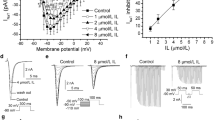Abstact
Objective
To study the effect of salvianolic acid A (SAA) on L-type calcium current (I-CaL) in isolated ventricular myocytes of Sprague-Dawley rats.
Methods
SAA powder was dissolved in normal Tyrode’s solution to reach the concentrations of 1, 10, 100, and 1000 μmol/L. The traditional whole-cell patch-clamp recording technique was employed to evaluate the effects of SAA on I-CaL in single ventricular myocytes which were prepared by Langendorff perfusion apparatus from Sprague-Dawley rats.
Results
SAA (1, 10, 100, and 1000 μmol/L) inhibited I-CaL peak value by 16.23%±1.3% (n=6, P<0.05), 22.9%±3.6% (n=6, P<0.05), 53.4%±3.0% (n=8, P<0.01), and 62.26%±2.9% (n=6, P<0.01), respectively. SAA reversibly inhibited I-CaL in a dose-dependent manner and with a half-blocking concentration (IC50) of 38.3 μmol/L. SAA at 100 μmol/L elevated the I-V curve obviously, and shifted the half-active voltage (V0.5) from (−15.78±0.86) mV to (−11.24 ±0.77) mV (n=6, P<0.05) and the slope (K) from 5.33±0.74 to 4.35±0.74 (n=6, P>0.05). However, it did not alter the shapes of I–V curve, steady-state inactivation curve, or recovery from inactivation curve.
Conclusions
SAA inhibited I-CaL in a dose-dependent manner. It shifted the steady-state activation curve to a more positive voltage, which indicated that the drug affected the activated state of calcium channels, and suggested that the Ca2+ antagonistic effect of SAA be beneficial in the treatment of myocardial ischemia reperfusion injury.
Similar content being viewed by others
References
Lin TJ, Zhang KJ, Liu GT. Effects of salvianolic acid A on oxygen radicals released by rat neutrophils and on neutrophil function. Biochem Pharmacol 1996;51:1237–1241.
Liu YL, Liu GT. Inhibition of human low-density lipoprotein oxidation by salvianolic acid A. Acta Pharm Sin (Chin) 2002;37(2):81–85.
Du GH, Qiu Y, Zhang JT. Protective effect of salvianolic acid A on ischemia-reperfusion induced injury in isolated rat heart. Acta Pharm Sin (Chin) 1995;30:731–735.
Wang SB, Tian S, Yang F, Yang HG, Yang XY, Du GH. Cardioprotective effect of salvianolic acid A on isoproterenol-induced myocardial infarction in rats. Eur J Pharmacol 2009;615:125–132.
Li P, Ren JG, Duan CL, Lin CR, Liu JX. The effects of three components of Salviae miltiorrhizae Radix on anoxia and peroxidation injuries in neonatal cardiomyocytes. Pharmacol Clin Chin Mater Med (Chin) 2009;25(5):29–31.
Tytgat J. How to isolate cardiac myocytes? Cardiovasc Res 1994;28:280–283.
Cheikh A, Benkhalifa R, Bescond J, El Ayeb M, Raymond G, Cognard C, Potreau D. Depression of cardiac L-type calcium current by a scorpion venom fraction M1 following muscarinic receptors interaction involving adenylate cyclase pathway. Toxicon 2006;48:373–387.
Molleman A ed. Patch clamping. UK: John Wiley & Sons; 2003:128.
Kameyama A, Yazawa K, Kaibara M, Ozono K, Kameyama M. Run-down of the cardiac Ca2+ channel: characterization and restoration of channel activity by cytoplasmic factors. Pflugers Arch 1997;433:547–556.
Liu YY, Bai YL, Wang T, Du J, Zhang Y, Li BX, et al. Effects resveratrol on L-type calcium current in guinea pig ventricular myocytes. Chin Pharmacol Bull 2007;23:181–184.
Yellon DM, Hausenloy DJ. Myocardial repersusion injury. N Engl J Med 2007;357:1121–1135.
Hoffman JW Jr, Gilbert TB, Poston RS, Silldorff EP. Myocardial reperfusion injury: etioloty, mechanisms, and therapies. J Extra Corpor Technol 2004;36:391–411.
Mcnown IB, Adgey AA. Cardioprotective therapy and sodium-hydrogen exchange inhibition: current concepts and future goals. J Am Coll Cardiol 2001;38:1651–1653.
Piper HM, Garcia-Dorado D, Ovize M. A fresh look at reperfusion injury. Cardiovasc Res 1998;38:291–300.
Woods KL. Possible pharmacological actions of magnesiu in acute myocardial infarction. Br J Clin Pharmacol 1991;32:3–10.
Bao GH, Yu DJ, Qu JH, Zheng YF, Xu LN. Inhibition of oxygen free radicals in potassium channels of cardiac myocytes and the action of salvianolic acid A. Acta Acad Medi Sin (Chin) 1993;15:320–324.
Author information
Authors and Affiliations
Corresponding author
Additional information
Supported by the Key Project of National Science Foundation of China (No. 30830118) and the National Key New Drug Project (No. 2009ZX09301-005 and No. 2009ZX09303-003).
Rights and permissions
About this article
Cite this article
Wang, B., Liu, Jx., Meng, Hx. et al. Blocking effect of salvianolic acid a on calcium channels in isolated rat ventricular myocytes. Chin. J. Integr. Med. 18, 366–370 (2012). https://doi.org/10.1007/s11655-011-0707-1
Received:
Published:
Issue Date:
DOI: https://doi.org/10.1007/s11655-011-0707-1




